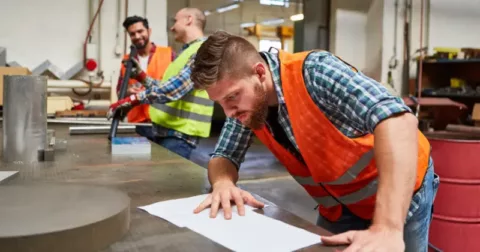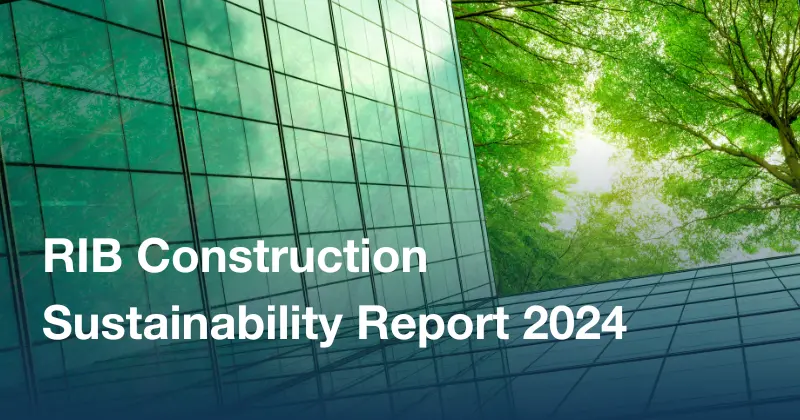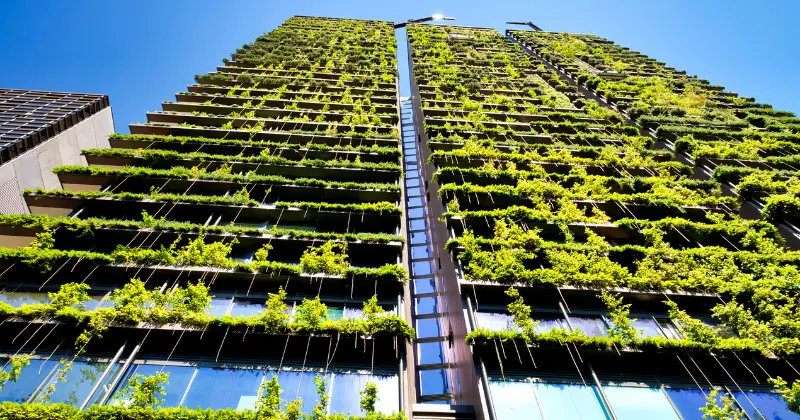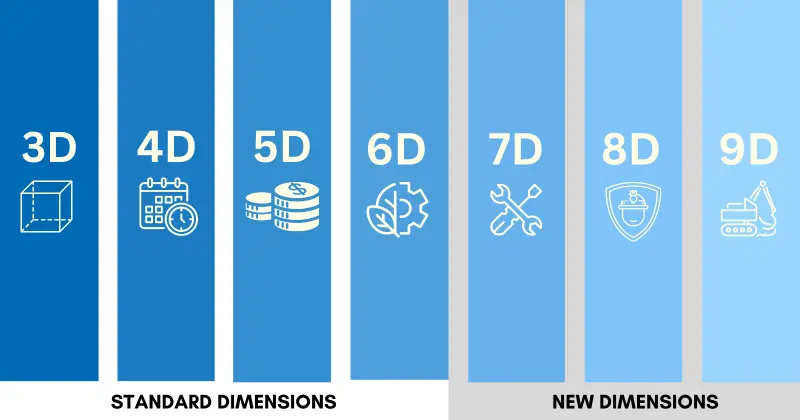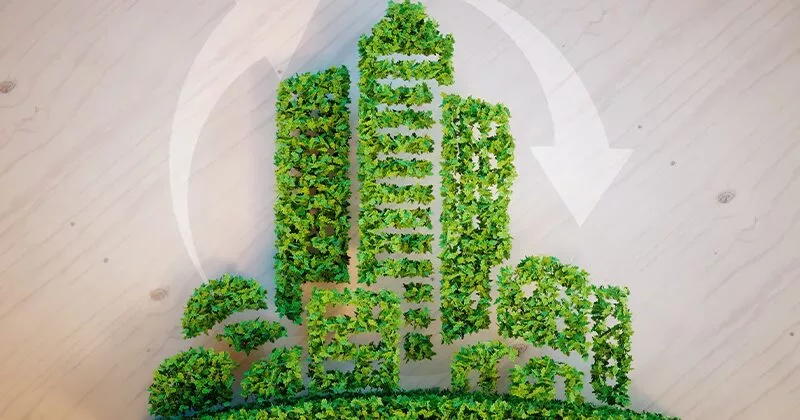11 mins read
Green Construction: Why, What & How to Be Part of the Change?
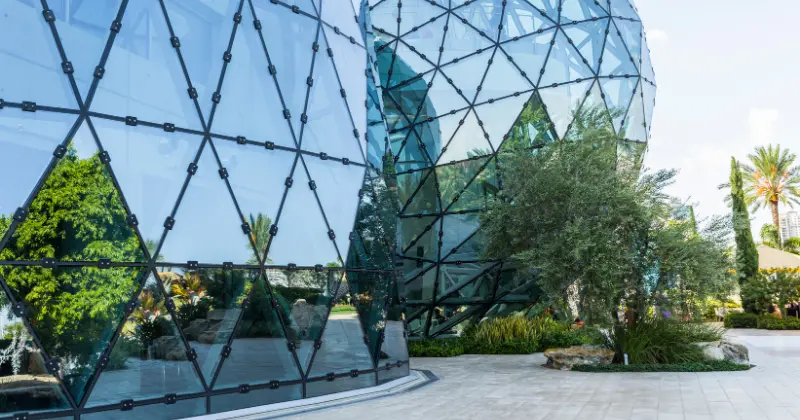
For the longest time, the construction industry received a free pass on the issue of being environmentally friendly. After all, buildings don’t actively belch smoke. However, examining the entire construction process reveals a different story: construction is a constant battle with nature. By clearing land for foundations, consuming resources to produce materials, and burning fossil fuels for transportation, our industry severely impacts the environment.
To mitigate these negative effects, a green building philosophy must be implemented. But what does that really entail? In this blog, we explore green construction, its benefits, challenges, and the trends shaping the future.
Why is a Greener Construction Industry So Important?
Sustainability has become one of the biggest challenges in construction today. This is not surprising, as statistics paint a gloomy picture for the industry, which accounts for 40% of worldwide carbon emissions, mainly from construction and operations. Additional stats from the US show that buildings account for 12% of the total water consumption, while heating and cooling systems account for 40% of all the energy used in the country.
The situation is not different in other parts of the world. In Europe, construction products produce a massive footprint of 250 million tonnes of carbon each year. In Australia, the building industry produces 27 million tonnes of annual waste, from which 20 million tonnes end up in landfills.
Despite these concerning numbers, action is actively being taken to change the sector’s situation. Companies and regulators have started a mindset shift towards a greener construction industry, where sustainable materials, renewable energy sources, smarter building methods, and much more are becoming the new norm.
According to the World Green Building Council, a green building reduces or eliminates negative impacts on our climate and natural environment and can create positive impacts. Simply put, going green is about design, the materials used, and minimizing environmental repercussions during and after construction.
While there is an active interest in changing the situation, especially from the side of regulators, companies, and owners are still skeptical. This is especially true considering green buildings can cost up to 12% more than similar non-green projects. However, this varies based on project scope, location, and early integration of sustainable strategies. Still, the benefits might outweigh the up-front costs, and owners might see a return on investment sooner than expected.
Green Building Benefits
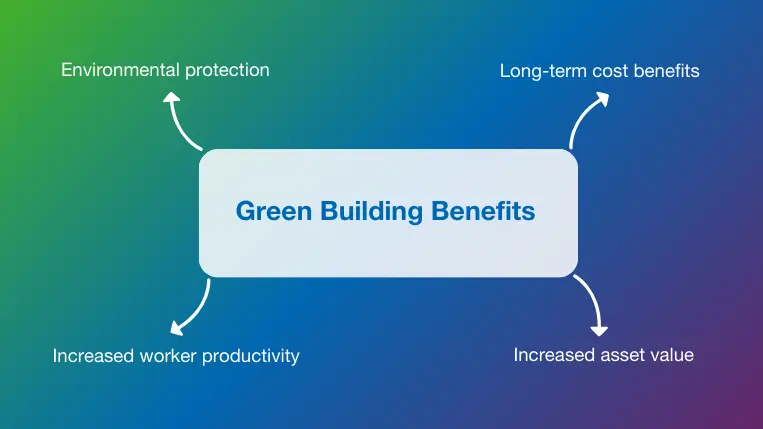
Construction is one of the biggest and oldest industries on the planet. By integrating sustainability into all aspects of a project, from design to operation and maintenance, we can maximize growth while leaving an environmentally friendly legacy. Some concrete green construction benefits include:
Environmental protection
The most significant benefit of green construction is reducing environmental impact. Green building techniques, methods, and systems ensure natural resources like energy and water are used smartly and with minimum waste. These smart systems also help reduce air and sound pollution during construction, minimizing the impact on communities and potential wildlife living near the site. Additionally, sustainable construction practices allow for better planning and estimation of materials, reducing waste and rework.
Long-term cost benefits
The first question asked on every project is: “What will it cost? “Traditional thinking has always been that going green costs more. This has become one of the biggest challenges for adopting green practices across construction projects. However, the long-term benefits outweigh the costs. Findings in the World Green Building Trends 2021 SmartMarket Report show some positive long-term financial returns. New green buildings are expected to have an average reduction in operating costs of 10.5% in the first year, with five-year savings reaching 16.9%.
Increased asset value
Paired with the long-term savings from reduced energy and water consumption during construction and operation, green buildings are also considered to have an increased asset value compared to traditional, non-environmentally conscious projects. As investors and occupants become more aware and concerned about the built environment’s impacts, green structures become easier to market, with more people interested in renting or buying. This is confirmed by an analysis from CBRE, stating that rent in U.S. office buildings that are LEED certified is 31% higher than in non-LEED certified ones.
Increased worker productivity
Expanding on the point above, worker productivity is another benefit from greener construction, which also increases the asset’s value. A 2021 study from the Harvard T.H. Chan School of Public Health showed that employees from various industries found that improved indoor environmental quality in green buildings significantly increased cognitive function among office workers. Additional research suggests that exposure to natural lightning and access to nature can contribute to employee satisfaction and productivity. This might not seem like a direct benefit for construction firms. However, it indirectly benefits them as organizations prioritize renting or buying comfortable spaces for their employees.
Engineering the Future: Green Building Trends
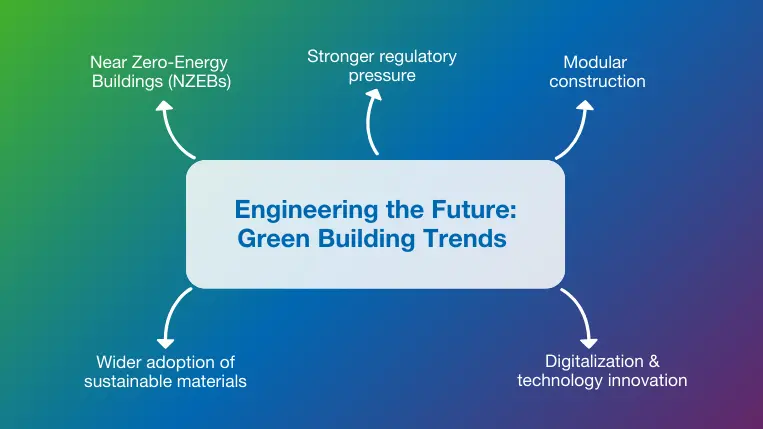
Green building also means smart building. Several technologies and innovations have been developed in recent years to boost industry sustainability. Below, we explore some of the current trends that are shaping the transition to a greener industry.
1. Near Zero-Energy Buildings (NZEBs)
The concept of “Nearly Zero-Energy Buildings” or NZEBs was coined by the European Commission to improve the energy efficiency of buildings as a part of the long-term strategy of fully decarbonizing construction. Although the name suggests NZEBs are buildings that don’t consume “nearly” any energy, it is not precisely that. In reality, NZEBs are buildings that produce as much energy as they consume over a year, with the bit of energy needed coming from renewable sources. Since 2020, all new European buildings have been required to be NZEBs, with plans underway to transition to zero-emission buildings starting in 2028 for new public projects and 2023 for new construction.
The NZEB market was valued at $43497.6 million in 2024 and is expected to grow to $167988.25 million by 2032. In addition to Europe, other regions like China, Asia-Pacific, and North America are experiencing rapid growth and adoption of NZEB standards as the focus on sustainability heightens.
2. Stronger regulatory pressure
With sustainability at the center of the conversation, we can expect to see increased regulatory pressure and new standards coming out to force industry stakeholders to address the issue. In Europe, the latest Construction Product Regulations introduced Digital Product Passports, which provide crucial safety, performance, and sustainability data about a product, facilitating reliable carbon footprint calculations for entire buildings. In Australia, starting in 2026, any office “acquired, constructed, or committed to under pre-commitment agreements with a value exceeding $15 million must obtain a minimum 4 Star Green Star certification”. In Norway, Oslo has become the first city in the world to mandate that all city-managed projects should be free from toxic emissions, requiring the use of quiet, low-emission machinery.
These are just a few of the several new standards and regulations expected to shift the industry in the coming decade. They apply to big buildings, industrial structures, and the residential sector.
3. Modular construction
Modular construction, also referred to as prefab construction, has positioned itself as a powerful innovation driving the green construction industry. The concept involves manufacturing building components in a controlled factory environment to be transported to the construction site for assembly. Precast concrete is an excellent example of modular construction, where concrete elements like walls, floors, or beams are produced off-site, offering increased quality and safety.
Some ways in which modular construction boosts sustainability include:
- Energy efficiency thanks to better insulation and sealing, which minimizes air leakage, improves thermal performance, and reduces energy consumption for heating and cooling.
- Smart material usage thanks to a controlled manufacturing process and sustainable materials that minimize environmental harm.
- Reduced waste thanks to off-site manufacturing, resulting in less debris and landfill contributions and an overall cleaner construction process.
Additional benefits of modular construction, such as increased productivity and efficiency due to structures being built faster, which also reduces project costs, position this innovative technology as one of the most popular green building trends of the moment.
4. Digitalization & technology innovation
Among the biggest green construction trends are digitalization and technology innovation. Artificial Intelligence (AI) is used to develop more energy-efficient designs by analyzing building orientation, materials performance, and insulation. At the same time, AI can use historical data from previous similar projects to simulate the required labor and resources, helping minimize waste. After construction is completed, AI can also analyze data from sensors and systems and find areas of improvement for energy efficiency and reduced emissions.
However, as beneficial as AI can be, it also has a significant environmental impact, so regulations are also being proposed to mitigate those effects. For example, in New York, new legislation was introduced requiring large data centers, including those used for AI, to report on energy use and emissions.
BIM is another technology that is widely used to support green efforts. The advanced visual and data-driven nature of BIM models allow construction stakeholders to simulate different design decisions, material choices, and many other relevant details that ensure buildings are sustainable across the entire project lifecycle. Professional carbon accounting software like RIB CostX mixes the power of estimating and BIM technologies with innovative carbon accounting features, allowing companies to estimate the impact of different material and design choices and track and report on their carbon emissions.
5. Wider adoption of sustainable materials
Sustainable construction materials, such as bamboo, cork, recycled steel, and more, have been around for a while. However, as regulatory pressures become stronger, we can expect a wider adoption of these materials to improve resource efficiency and reduce the environmental impact of traditional materials.
Some new alternatives to widely contaminating materials are also being tested and implemented. For example, in 2024, the MycoHAB project in Namibia opened Africa’s first structural mycelium building, constructed entirely from bricks produced locally using agricultural waste and mycelium growth. Mycelium, the root structure of fungi, can be cultivated into lightweight, biodegradable materials suitable for insulation, panels, and even structural components. The material is very promising because it is biodegradable, has a low carbon footprint, and consumes little to no energy during production. Although mycelium composites have been around for a while now, their widespread application is recent, and we can expect wider adoption in the coming years.
Green Construction Management Tips & Techniques
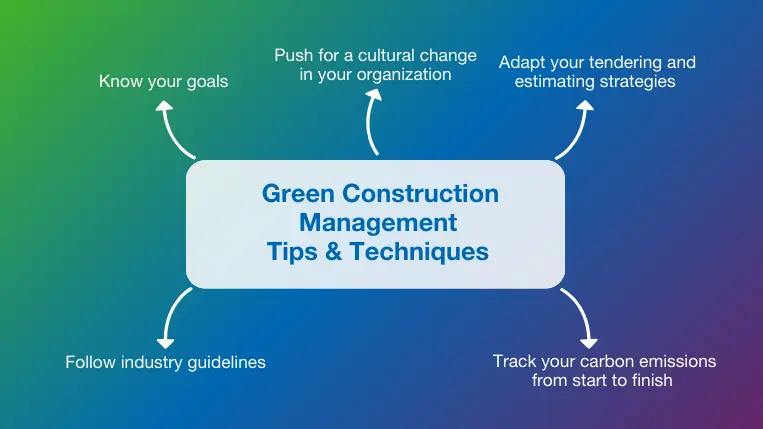
Understanding the importance and benefits of a greener construction industry is one thing; implementing that change is another thing. Successfully transitioning into sustainable practices requires careful planning, company-wide adoption, and the support of the right tools.
Know your goals
Defining your goals and priorities is the first step towards a successful green construction adoption. A common mistake when transitioning to greener practices is trying to do it all without a clear focus, which can waste time and resources. A clear goal like reducing carbon emissions by 10% or switching to entirely sustainable materials by the end of the year can help prioritize budgets, select the right tools, and effectively measure progress, making the process much more effective and successful.
Push for a cultural change in your organization
We will not write a thousand words about the construction industry’s reluctance to change. Anyone who works in the sector already knows that it is a reality. The situation is no different when it comes to sustainability. RIB’s 2024 construction sustainability report found that sustainability not being a priority for clients, concerns about increased costs and impact on schedules, and not believing it can have a meaningful effect, are a few reasons for not tracking the environmental impact of their work. Another big reason cited in the report is a lack of knowledge on measuring it, highlighting the importance of education.
Considering all that, the first tip for an effective transition into greener practices is to involve the entire organization in the process. Educate stakeholders about the benefits and importance of going green, as well as the tools and techniques that must be used to achieve it. Setting internal sustainability goals can be a great way to motivate change through measurable numbers.
Adapt your tendering and estimating strategies
When estimating costs, you must expand your existing tendering process by several steps. A phrase you’ll often hear is “Plan for Simplicity and Efficiency,” but the simplest route isn’t always the easiest one. How are you managing your materials from source to usage? Can your team minimize waste and dispose of it without environmental damage? Can your equipment be disassembled for reuse, cutting renovation costs? And what impact will the building have in ten years? It’s like camping: Leave only your footprints behind.
Green is how the market is moving, which can seem daunting. But it’s best to start preparing for the future now, even if it is slowly. Research shows that current in-use buildings can reduce energy consumption by 30% – 50% using already available technologies. Significant breakthroughs are available; from a Japanese brick-making process that locks away carbon dioxide to a Nigerian programme that turns agricultural waste into particleboard for use as a low-cost building material. In the end, how green you go is up to you. Costs will always play a role, but finding the correct balance will set you apart and ultimately help save the planet.
Track your carbon emissions from start to finish
Any successful green strategy starts with accountability. Tracking carbon emissions throughout the entire project lifecycle is essential to finding areas for improvement and evaluating the effectiveness of your current sustainability efforts.
Using professional carbon estimating solutions like RIB CostX can make the process far more accurate and time efficient. CostX is an active sponsor of Building Transparency, a non-profit organization that developed a powerful Embodied Carbon in Construction Calculator (EC3) that houses a robust database of Environmental Product Declarations (EPDs). CostX users can access the EC3 database to estimate the emissions of different building components and select the most aligned with their goals.
Follow industry guidelines
With the global community pushing for a greener construction industry, it’s best to follow guidelines set by an internationally recognized body equipped with specialist tools for measuring and rating how green a building is. These standards provide clear benchmarks for energy efficiency, waste management, carbon reduction, and much more. They also make it easier for buildings to secure certifications, as every process is aligned with industry guidelines. Widely recognized standards include LEED, BREEAM, WELL, and other regional-specific frameworks.
Final Thoughts
The construction industry is becoming greener by the day. An increasing number of regulations and standards being implemented worldwide are forcing organizations to track and mitigate their projects’ environmental impact. In that sense, education about measurement methods, sustainable materials, and greener building methods is fundamental for success.
At RIB Software, we are committed to a greener and more environmentally friendly industry. The powerful carbon estimating capabilities of RIB CostX make it the perfect solution to support your company’s sustainability journey. In-built reporting allows you to analyze the impact of your green strategies, helping you find improvement opportunities in real time to ensure you meet your sustainability goals.
If you want to gain a competitive advantage through increased compliance, reduced costs, and decreased environmental impact, get your free demo for RIB CostX today!

Most Recent
11 mins read
10 mins read
10 mins read
29 mins read
Blog Categories
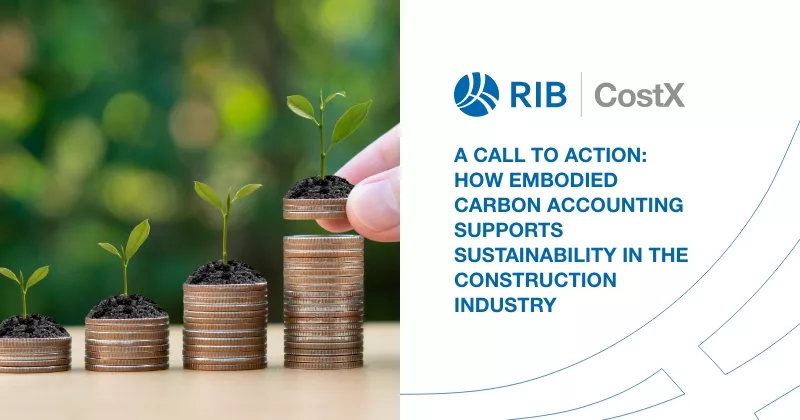
Ebook
